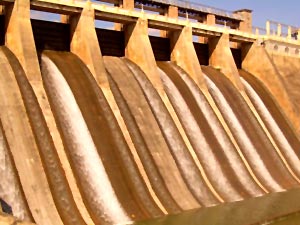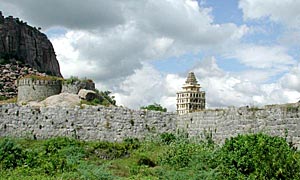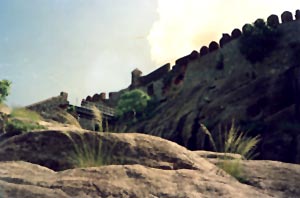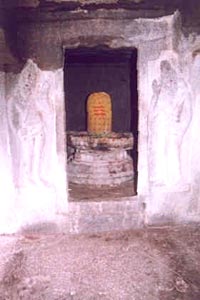Thiruvannamalai is a historic holy place, situated about 175 km from Chennai. It is considered to be a place of salvation or the `Mukthi Sthalam` for several saints like Gugai Namachivayar, Seshadri Swamigal, Ramana Maharishi, Arunagirinathar etc.
There are various places to visit here including the caves and shelters of holy men. It is one of the `Pancha Bootha Sthalams` (places of five elements) and the element here is Fire or `Agni`. In Sanskrit, Thiruvannamalai is called `Sonachalam`, which means `red mountain`, symbolic of fire.
Some of the visiting places of Thiruvannamalai are given here:
Sathanur Dam of Thiruvannamalai
 One of the relaxing places of Thiruvannamalai is the Sathanur Dam, situated 22 miles away from here. It is constructed across the river Pennar submerging a huge forest between two mountains. Here, one can also see a well laid out garden and well lit fountain. The visitors are attracted here for the swimming pool, a crocodile park and motor launch in the dam. This dam in Thiruvannamalai is suitable for one or two days stay. The tourists can avail the separate cottages, which are available with boarding.
One of the relaxing places of Thiruvannamalai is the Sathanur Dam, situated 22 miles away from here. It is constructed across the river Pennar submerging a huge forest between two mountains. Here, one can also see a well laid out garden and well lit fountain. The visitors are attracted here for the swimming pool, a crocodile park and motor launch in the dam. This dam in Thiruvannamalai is suitable for one or two days stay. The tourists can avail the separate cottages, which are available with boarding.
Arakandanallur
This place is situated near Thiruvannamalai. A Siva shrine of olden times with three caves carved by the Pallavas can be seen here. It is said that the saint Ramana Maharishi got his first vision of supreme truth here and was drawn to Thiruvannamalai.
Kuvakam Koothandavar Koil
This place is situated 22 km south of Thirukoilur. It is famous for its annual festival of Aravan, the son of Arjuna. This festival is held in the month of May and the unique feature of this festival is that eunuchs from all over India assemble here to perform a vow to get married to Koothandavar at night and get widowed by next dawn. Thousands of these eunuchs visit and perform this vow.
Gingee Fort of Senchikkottai
 This fort is about 150 km away from Chennai on the road to Thiruvannamalai. During the 9th century, this fort was a stronghold of the Cholas. Later, the Vijayanagar kings equipped and made it an impenetrable fortress.
This fort is about 150 km away from Chennai on the road to Thiruvannamalai. During the 9th century, this fort was a stronghold of the Cholas. Later, the Vijayanagar kings equipped and made it an impenetrable fortress.
Rajagiri
It is the tallest rising at 600 ft in Thiruvannamalai. It is surrounded by massive granite walls pierced with gates and towers occupying about an area of 12 sq. km. One needs to climb the fort through a serpentine flight of rough steps. On the way to Rajagiri, the visitors can see the granaries, dungeons, queen`s quarters, cool pools and a temple called Kuvalakanni temple. The citadel is unfriendly as it is perched on a steep cliff enclosed by deep gaps. The only way to go there is by an artificial bridge thrown across one such wide gap of 25 ft. wide and more than 80 ft. in depth.
Reaching in Rajagiri of Thiruvannamalai, big cannon in a mandap can be seen. It is facing the plains which once might have growled emitting volleys of fire on the enemy army approaching the plains.
Beehives cling to the precipitous sides and one can witness a thrilling sight of the hill tribes extracting honey dangling in the air. The Cholas, Vijayanagar kings, Rajputs, Marathas, French, Nawabs, the Nayaks and the English evinced keen interest in keeping the strategic citadel.
 The small hill is climbed by a flight of steep steps cut on the buttress of the fort. It is said that the ballads of Raja Desingh immortalised the fort. He defeated the Mughals with a great courage but was later killed deceitfully. After his death, the entire harem committed sathi, means self immolation. Even today a pit near the tank called `Chakkara Kulam` is shown as the place where it happened.
The small hill is climbed by a flight of steep steps cut on the buttress of the fort. It is said that the ballads of Raja Desingh immortalised the fort. He defeated the Mughals with a great courage but was later killed deceitfully. After his death, the entire harem committed sathi, means self immolation. Even today a pit near the tank called `Chakkara Kulam` is shown as the place where it happened.
Panamalai
This place is situated on the road to Villupuram from Gingee on the southern side. A famous Siva temple called Thalapuriswara was built here by a Pallava king named Rajasimha. The fine wall paintings found here still exist in good condition and illustrates the typical Pallava style.
Mandagappattu
This is a famous rock-cut cave temple of Pallava king Mahendra Varma. It is situated about 17 km on the way to Gingee from Villupuram. The king proudly said that this temple built by him will last for ever as they are made without mud and wood.
Mel-Sittamur
This place is the headquarters of the chief Jain monk and possesses rare Jain manuscripts. It can be seen on the way to Tindivanam from Gingee. One can see lots of temples here, which are dedicated to Jain Tirthankaras. The Jain temples of Mylapore were shifted to this remotely placed inland during the beginning of Christian era when portions of Mylapore were submerged under the sea. Some fine carvings can be seen here in this place. This temple is often visited by the Jain research scholars. A good number of Jains scattered nearby come for worship.
Dhalavanur
 This is another rock-cut temple built by Mahendra Varman, the Pallava king. The temple here is called Satru Malleswaram. The name is derived from Satrumalla, one of the titles of Mahendra Varman.
This is another rock-cut temple built by Mahendra Varman, the Pallava king. The temple here is called Satru Malleswaram. The name is derived from Satrumalla, one of the titles of Mahendra Varman.
Thiruvakkarai
The temple here is a place to be visited by the tourists. It is situated near Tindivanam on the banks of the river Varaha Nadhi. Some part of this temple was erected by Sembian Mahadevi, the Chola queen.
The place has various reasons to be curious. The entrance way is not aligned in a line. The Nandi of this temple is also taken away from its usual place in front of the sanctum. An unusual mudra of the Chathura Dance pose of Nataraja can be seen here. Another reason behind this place being famous is the trees that have become rocks and fossilised due to passage of time. In a special park, these are displayed. Hundreds of people gather here during full moon nights to worship the multi-handed Kali known as Vakra Kali Amman enshrined near the front gopuram. Here, is a strange convention regarding the puja in this temple. The regular Puja is performed in the period known as `Ragukalam` or the period under the influence of Ragu.
Sanyasikuppam
This place is visited for seeing the standing carved stone bulls. These can be seen on the way to Pondicherry from Tindivanam.



















